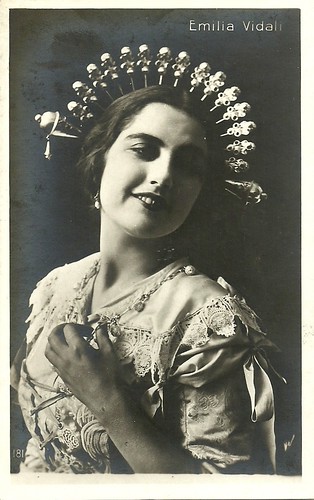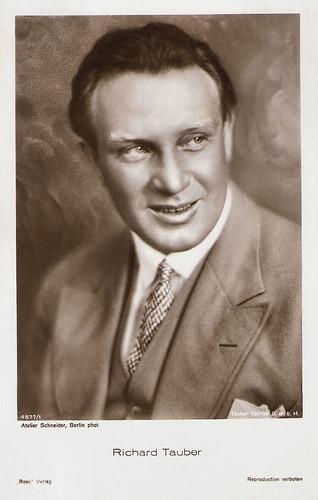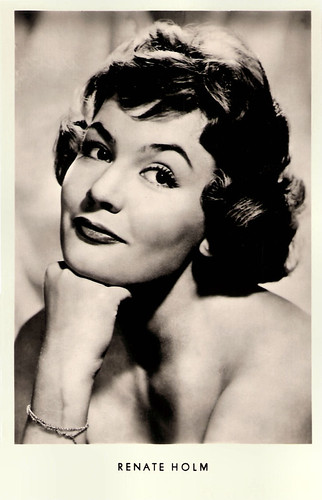
French postcard by Ed. M.T. & C. (Maurice Tesson), no. S.129/1.
Berta Nelson (?-?) was a Russian opera singer, who from 1913 onward had a career as an actress in Italian silent cinema. She worked at Itala Film and even had her own company, Nelson Film.

Italian postcard by G. Vettori, Bologna, no. 181. Photo: Emilia Vidali as Lucia in I promessi sposi/The Betrothed (Mario Bonnard, 1922).
Emilia Vidali (?-?) was an actress in Italian silent cinema. She was also an extremely popular opera singer in South America and performed in international opera houses worldwide.

French postcard by Editions Cinémagazine-Edition, no. 62. Photo: Pathé Consortium Cinema. Jean Périer as Mazarin in Vingt ans après/The Return of the Musketeers (Henri Diamant-Berger, 1922). Collection: Didier Hanson.
French operatic baritone and actor Jean Périer (1869-1954) had a long association with the Opéra-Comique in Paris. Although he sang principally within the operetta repertoire, Périer portrayed roles in operas by Wolfgang Amadeus Mozart and Giacomo Puccini, and he originated the role of Pelléas in Claude Debussy's 'Pelléas et Mélisande' in 1902. Périer also appeared in over 30 films between 1910 and 1948.

Italian postcard. Collection: Didier Hanson.
Enrico Caruso (1873-1921) was an Italian operatic tenor. He sang to great acclaim at the major opera houses of Europe and the Americas, appearing in a wide variety of roles from the Italian and French repertoires that ranged from the lyric to the dramatic. Between 1908 and 1919 he appeared in five films.

Austrian postcard by B.K.W.I. (Brüder Kohn, Wien). Feodor Chaliapin as Don Quixote.
Russian opera singer Feodor Chaliapin (1873–1938) was an international sensation and is considered the greatest Russian singer of the twentieth century, as well as the greatest male operatic actor ever. The possessor of a large, deep and expressive basso profundo, he was celebrated at major opera houses all over the world and established the tradition of naturalistic acting in operas. The only sound film which shows his acting style is Don Quixote (Georg Wilhelm Pabst, 1933).

French postcard by S.I.P., 30th series, no. 2. Photo: Reutlinger, Paris. Mailed in 1902.
Around 1900, Italian soprano Lina Cavalieri (1874-1944) was considered 'the most beautiful woman on earth'. While she started as a Paris café-concert singer in the 1890s, she soon rose to stardom at the Folies-Bergères. In 1900 she embarked on a new career as an opera singer, thus becoming an internationally acclaimed star and a fashion and beauty model, from Russia to the US. In the 1910s she started a film career in the US and Italy, with her husband Lucien Muratore.

French postcard in the Les Vedettes de Cinéma series by A.N., Paris, no. 102. Photo: P. Nadar. Vanni Marcoux as Méphistophélès in Gounod’s 'Faust'? Or Vanni Marcoux in Le Miracle des Loups/Miracle of the Wolves (Raymond Bernard, 1924)?
Vanni Marcoux or Vanni-Marcoux (1877–1962) was a French operatic bass-baritone, renowned as one of the most memorable singing actors of the 20th century. Marcoux only acted in three silent films and one sound film, but these were significant leads.

German postcard by PH, no. 4116/1. Geraldine Farrar as Marguerite in Charles Gounod's opera 'Faust'.
American soprano opera singer and film actress Geraldine Farrar (1882-1967) was noted for her glamorous beauty, acting ability, and the timbre of her voice. Barely 20, she was already the toast of Berlin. Later at the Met in New York, she had a large following among young women, who were nicknamed ‘Gerry-flappers’. Farrar also starred in more than a dozen silent films from 1915 to 1920. She was married to and co-starred with Dutch matinee idol Lou Tellegen.

German postcard by Verlag Hermann Leiser, no. 1453. Photo: Berl. Illustr. Ges., Berlin. Bernhard Bötel and Mizzi Fink in 'Der Postillon von Lonjumeau', based on the French comic opera 'Le Postillon de Lonjumeau'.
German baritone Bernhard Bötel (1883-1953) was particularly successful as the title character in 'The Tales of Hoffmann' at the Komische Oper in Berlin. He later had a significant career as an operetta singer in Vienna, and took part in the world premiere of the Lehár operetta 'Der Graf von Luxemburg' in 1909. Later he was a valued member of the Berlin Municipal Opera as a tenor buffo for twenty years. At the same time, he appeared as an operetta singer and was celebrated as the partner of the famous diva Fritzi Massary. Bötel also acted in four films: a recording from a song and dance from Der Graf von Luxemburg (1910), a film version of Flotow's opera Martha (Gustav Schönwald, 1916) with Mizzi Fink in the title role, Rheinzauber (Joseph Max Jacobi, 1920), and Trick-Track (Emil Albes, 1921). The latter film was an experiment with the conductor printed on the lower base of the film, to better synchronize the live music with the film.

German postcard by Verlag Hermann Leiser, no. 2541. Photo: Alex Binder, Berlin.
German Opera singer Karl Armster (1883-1943) was one of the most popular baritones up to the Second World War. He excelled in verismo roles from Scarpia to Marcello. He was also a renowned Wagner singer in the 1910s. Between 1919 and 1921 he acted in four silent films including Friedrich Zelnik's Hölle der Jungfrauen (1919) with Blandine Ebinger and Fasching (1921) with Lya Mara.

Italian postcard by Ed. G.B. Falci, Milano, no. 56. Photo: La Fotominio.
American opera singer Carolina White (1885-1961) had a short-lived film career. She played opposite the famous opera singer Enrico Caruso in My Cousin (Edward José, 1918). In 1921 she played the love interest of Luciano Albertini in the 4-part episode film Il ponte dei sospiri, directed by Domenico Gaido, and partly shot on location in Venice. After that White didn't act in film anymore.

German postcard by Verlag Hans Dursthoff, Berlin, no. 1027. Photo: Willinger, Berlin. Paul Hansen sang in the opera 'Der Freischütz' but also acted in the silent film Der Freischütz (dir. unknown, 1918).
Paul Hansen (1886-1967) was a Danish opera singer (tenor/baritone) and actor in German silent films. During his time in Berlin, the star tenor was offered several silent film roles. He made his film debut during the First World War in an adaptation of 'Cavalleria rusticana', the one-act opera by Pietro Mascagni. In the early days of the Weimar Republic, Hansen appeared in around 20 films, including three of the eight parts of Joe May's epic Herrin der Welt/Mistress of the World (1919). In just five years (1919 to 1924), he was a film partner to such stars as Ossi Oswalda, Pola Negri, Harry Liedtke, Lil Dagover and, finally, Henny Porten twice.

Italian postcard. Picture by Nanni. Tito Schipa (tenor) as the Duke of Mantua in 'Rigoletto'.
Italian tenor of Albanese descent Tito Schipa (1888-1965) was considered the best 'tenore di grazia' (light tenor) in history. He also acted in various Italian sound films of the 1930s and 1940s.

German postcard by Ross Verlag, no. 9085/1, 1935-1936. Photo: Badal Filmproduktion.
British opera singer and actor Louis Graveure (1888-1965) starred in four German films of the 1930s. In 1931, he emigrated to Berlin to sing at the Deutsche Oper where he sang five roles: 'Faust', 'Rodolfo', 'Pagliacci', 'Don José', and 'Lohengrin'. Because of his magnetic stage presence and electric delivery, he was enormously popular with the Berliners. This led to a series of four films.

German postcard by NPG, no. 994. Photo: Angelo, Budapest, 1918. Collection: Didier Hanson.
Emmi Kosáry (1889-1964) was a Hungarian opera diva and operetta prima donna with a beautiful soprano voice. She also became a film actress, who worked in Hungary with the young Michael Curtiz. Kosáry was the wife of composer Ákos Buttykay.

German postcard by Ross Verlag, no. 9400/1, 1935-1936. Photo: Itala Film.
Beniamino Gigli (1890-1957) was one of the most famous Italian opera singers, internationally respected for the beauty of his voice and his vocal technique. Between 1935 and 1950 he also starred in various Italian fiction films.

German postcard by Ross Verlag, no. 4877/1, 1929-1930. Photo: Atelier Ernst Schneider, Berlin / Tauber Tonfilm G.m.b.H.
Austrian opera singer Richard Tauber (1891-1948) was one of the world's finest Mozartian tenors of the 20th century. Some critics commented that 'his heart felt every word he sang'. He also tested the then-new talking pictures in such popular musical films as Ich küsse Ihre Hand, Madame (1929) with Marlene Dietrich, Das Land des Lächelns (1930) and Melodie der Liebe (1932).

Italian postcard. Portrait by Nanni. Soprano Toti Dal Monte as the title character in the Donizetti opera 'Lucia di Lammermoor', one of her famous performances, together with Donizetti's 'Elisir d'amore' and Puccini's 'Madam Butterfly'.
Italian operatic soprano Toti Dal Monte (1893-1975) is remembered today for her performance as Cio-cio-san in Puccini's 'Madama Butterfly'. She recorded this role in 1939 with Beniamino Gigli as Pinkerton. She also achieved great success in such films as Il carnevale di Venezia (1939), Giacomo Gentilomo (1939) and Cuore di Mamma (1954).

German postcard by Ross Verlag, no. 7290/1, 1932-1933 (sent by mail in the Netherlands in 1935). Photo: Atelier Schneider, Berlin. Willi Domgraf-Fassbaender in the stage operetta 'The Student Prince' (1932).
Celebrated German opera singer Willi Domgraf-Fassbaender (1897-1978) was one of the leading lyric baritones of the inter-war period. He was particularly associated with Mozart and Italian roles. ‘The Italian baritone’ starred in the 1930s in several musical films, which helped his shining international reputation.

Italian postcard by B.F.F. Edit., no. 2989. Collection: Marlene Pilaete.
Nothing really predestined Grace Moore (1898-1946) to become an opera diva and a movie star, as she was born in rural Tennessee in a conservative and religious family. But, by a combination of ambition, perseverance, fierce drive and hard work, she achieved her goal. She first found fame in Broadway musicals and then became a prima donna at the prestigious Metropolitan Opera. After an unsuccessful turn at MGM in 1930, she finally made it in Hollywood in 1934 at Columbia and helped to make movie audiences love opera.

German postcard by Ross Verlag, no. 6853/1, 1931-1932. Photo: Lydor, Berlin / Aafa Film. Hans Stüwe in Trenck - Der Roman einer großen Liebe (Ernst Neubach, Heinz Paul, 1932).
Hans Stüwe (1901-1976) was a German singer and opera director. In 1923 he made his debut as a baritone at the Stadttheater in Königsberg. He would engage in directing operas and through the years he presented many forgotten operas and published also books on music theory. From 1926 on he was also a big film star in Germany. Four times he was the film partner of Ufa diva Zarah Leander.

German postcard by Ross Verlag, no. 7049/1, 1932-1933. Photo: Frhr. von Gudenberg Phot.
Hungarian-born Gitta Alpár (1903-1991) was a Jewish actress, opera and operetta singer, and dancer, whose successful career in Germany was broken by the Nazis. In 1927 she started to sing at the Wiener Staatsoper (Vienna State Opera). Her nickname was 'The Hungarian Nightingale'. Later she moved on to Berlin, where she sang in operas like 'Die Zauberflöte' (The Magic Flute) by W.A. Mozart as the Queen of the Night. After her marriage to film star Gustav Fröhlich, she starred in several films.

Italian postcard by Grafiche N. Moneto, Milano. Photo: Itala-Film / Generalcine. Maria Cebotari in Mutterlied/Solo Per Te/Mother Song (Carmine Gallone, 1937).
Celebrated Romanian soprano and actress Maria Cebotari (1910-1949) was one of Europe's greatest opera stars in the 1930s and 1940s. Especially her interpretations of the works of Wolfgang Amadeus Mozart and Richard Strauss belonged to her specialities. Cebotari also starred in several films related to opera.

Hungarian postcard by Athenaeum Color. Photo: Metro-Goldwyn-Mayer. Ilona Massey and Nelson Eddy in Balalaika (Reinhold Schünzel, 1939).
Statuesque blonde Ilona Massey (1910-1974) was a Hungarian opera singer who also appeared in some Austrian films before she was discovered by Hollywood mogul Louis B. Mayer. MGM billed her as 'the new Dietrich' and showcased her in operettas with popular baritone Nelson Eddy. But somehow her Hollywood career never really took off.

Italian postcard by ASER, no. 173. Photo: De Antonis.
Beautiful Nelly Corradi (1914–1968) was an Italian opera singer and actress. She made her film debut in Max Ophüls’s La signora di tutti (1934) and had her biggest successes after the war with opera films like Lucia di Lammermoor (1946).

Italian postcard by Ballerini & Fratini Firenze Editori, no. 4248. Photo: Scalera Film. Imperio Argentina in Tosca (Jean Renoir, Carl Koch, 1941). While Renoir started the film, his scriptwriter and assistant Carl Koch finished the film and shot most of it. Luchino Visconti was an assistant director for this film. This postcard refers to a scene in which Argentina sings the aria of 'Caro mio ben' by Giuseppe Giordani.
Imperio Argentina (1906-2003) was a singer, dancer and actress, who appeared in more than 30 films. Although she was born in Buenos Aires, Argentina and was successful all over South America, she was a Spanish citizen. Besides in Spain and South America, she also worked in France, Italy and Germany.

German card by Eurodisc. Photo: Grimm.
Slim and handsome singer Rudolf Schock (1915–1986) was a lyrical tenor with a wide repertory from operetta to Lieder to Richard Wagner’s romantic opera Lohengrin. He sold over 3 million records and his German films made him almost a superstar of his day.

British postcard in the Picturegoer Series, London, no. D 40. Photo: Metro-Goldwyn-Mayer. Mario Lanza in The Great Caruso (Richard Thorpe, 1951).
Mario Lanza (1921–1959) was an American tenor, actor and Hollywood film star of the late 1940s and the 1950s. His masterpiece was The Great Caruso (Richard Thorpe, 1951), the top-grossing film in the world in 1951. Lanza's voice was so dazzling that an awestruck Arturo Toscanini called it the 'voice of the century'.

German promotion card by Columbia, no. DrW 2946 d. Photo: Angus McBean.
Greek-American soprano Maria Callas (1923–1977) was one of the most renowned and influential opera singers of the 20th century. Many critics praised her bel canto technique, wide-ranging voice and dramatic interpretations. Her repertoire ranged from classical opera seria to the bel canto operas of Donizetti, Bellini and Rossini and further, to the works of Verdi and Puccini; and, in her early career, to the music dramas of Wagner. Her musical and dramatic talents led to her being hailed as 'La Divina'. Her most famous film appearance was the title role in Pier Paolo Pasolini's Medea (1969).

East-German postcard by VEB Volkskunstverlag Reichenbach I.V., no. G 740, 1957. Retail price: 0,15 DM. Photo: Teldec.
Renate Holm (1931-2022) was a German-Austrian film actress and operatic soprano. During the 1950s she was a popular star of Schlager films and operettas. In the 1960s, she became a star at the Vienna State Opera under the direction of Herbert von Karajan.
Sources: Francisco Salazar (Operawire), Wikipedia and IMDb.
No comments:
Post a Comment